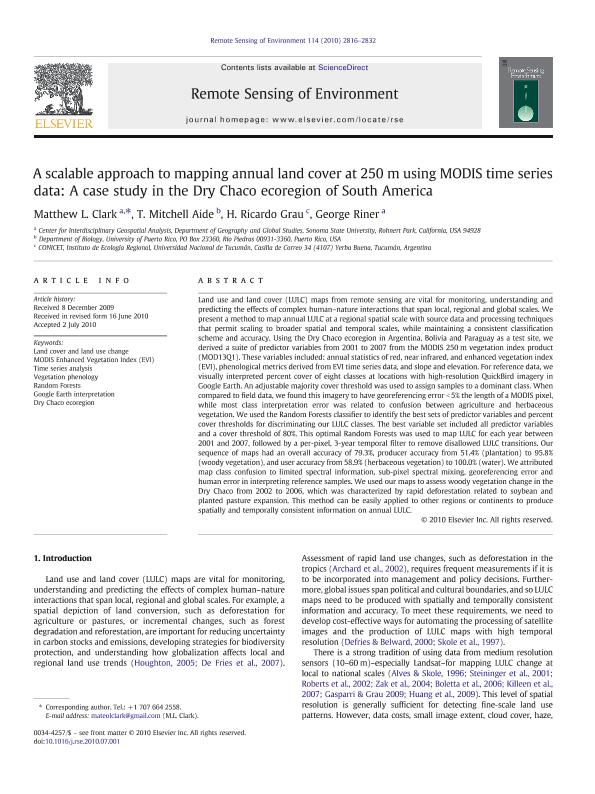Mostrar el registro sencillo del ítem
dc.contributor.author
Clark, Matthew L.
dc.contributor.author
Aide, T. Mitchell
dc.contributor.author
Grau, Hector Ricardo

dc.contributor.author
Riner, George
dc.date.available
2019-04-09T17:50:43Z
dc.date.issued
2010-11
dc.identifier.citation
Clark, Matthew L.; Aide, T. Mitchell; Grau, Hector Ricardo; Riner, George; A scalable approach to mapping annual land cover at 250 m using MODIS time series data: A case study in the Dry Chaco ecoregion of South America; Elsevier Science Inc; Remote Sensing of Environment; 114; 11; 11-2010; 2816-2832
dc.identifier.issn
0034-4257
dc.identifier.uri
http://hdl.handle.net/11336/73571
dc.description.abstract
Land use and land cover (LULC) maps from remote sensing are vital for monitoring, understanding and predicting the effects of complex human-nature interactions that span local, regional and global scales. We present a method to map annual LULC at a regional spatial scale with source data and processing techniques that permit scaling to broader spatial and temporal scales, while maintaining a consistent classification scheme and accuracy. Using the Dry Chaco ecoregion in Argentina, Bolivia and Paraguay as a test site, we derived a suite of predictor variables from 2001 to 2007 from the MODIS 250. m vegetation index product (MOD13Q1). These variables included: annual statistics of red, near infrared, and enhanced vegetation index (EVI), phenological metrics derived from EVI time series data, and slope and elevation. For reference data, we visually interpreted percent cover of eight classes at locations with high-resolution QuickBird imagery in Google Earth. An adjustable majority cover threshold was used to assign samples to a dominant class. When compared to field data, we found this imagery to have georeferencing error <5% the length of a MODIS pixel, while most class interpretation error was related to confusion between agriculture and herbaceous vegetation. We used the Random Forests classifier to identify the best sets of predictor variables and percent cover thresholds for discriminating our LULC classes. The best variable set included all predictor variables and a cover threshold of 80%. This optimal Random Forests was used to map LULC for each year between 2001 and 2007, followed by a per-pixel, 3-year temporal filter to remove disallowed LULC transitions. Our sequence of maps had an overall accuracy of 79.3%, producer accuracy from 51.4% (plantation) to 95.8% (woody vegetation), and user accuracy from 58.9% (herbaceous vegetation) to 100.0% (water). We attributed map class confusion to limited spectral information, sub-pixel spectral mixing, georeferencing error and human error in interpreting reference samples. We used our maps to assess woody vegetation change in the Dry Chaco from 2002 to 2006, which was characterized by rapid deforestation related to soybean and planted pasture expansion. This method can be easily applied to other regions or continents to produce spatially and temporally consistent information on annual LULC.
dc.format
application/pdf
dc.language.iso
eng
dc.publisher
Elsevier Science Inc

dc.rights
info:eu-repo/semantics/openAccess
dc.rights.uri
https://creativecommons.org/licenses/by-nc-sa/2.5/ar/
dc.subject
Dry Chaco Ecoregion
dc.subject
Google Earth Interpretation
dc.subject
Land Cover And Land Use Change
dc.subject
Modis Enhanced Vegetation Index (Evi)
dc.subject
Random Forests
dc.subject
Time Series Analysis
dc.subject
Vegetation Phenology
dc.subject.classification
Otras Ciencias Biológicas

dc.subject.classification
Ciencias Biológicas

dc.subject.classification
CIENCIAS NATURALES Y EXACTAS

dc.title
A scalable approach to mapping annual land cover at 250 m using MODIS time series data: A case study in the Dry Chaco ecoregion of South America
dc.type
info:eu-repo/semantics/article
dc.type
info:ar-repo/semantics/artículo
dc.type
info:eu-repo/semantics/publishedVersion
dc.date.updated
2019-04-05T16:11:23Z
dc.journal.volume
114
dc.journal.number
11
dc.journal.pagination
2816-2832
dc.journal.pais
Estados Unidos

dc.journal.ciudad
Nueva York
dc.description.fil
Fil: Clark, Matthew L.. Sonoma State University; Estados Unidos
dc.description.fil
Fil: Aide, T. Mitchell. Universidad de Puerto Rico; Puerto Rico
dc.description.fil
Fil: Grau, Hector Ricardo. Universidad Nacional de Tucumán. Instituto de Ecología Regional. Consejo Nacional de Investigaciones Científicas y Técnicas. Centro Científico Tecnológico Conicet - Tucumán. Instituto de Ecología Regional; Argentina
dc.description.fil
Fil: Riner, George. Sonoma State University; Estados Unidos
dc.journal.title
Remote Sensing of Environment

dc.relation.alternativeid
info:eu-repo/semantics/altIdentifier/doi/https://dx.doi.org/10.1016/j.rse.2010.07.001
dc.relation.alternativeid
info:eu-repo/semantics/altIdentifier/url/https://www.sciencedirect.com/science/article/pii/S0034425710002063
Archivos asociados
